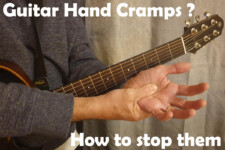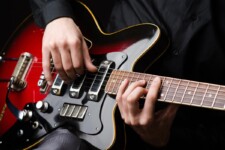Wrist Hurts in Fretting Hand When Playing Guitar? (Tips)
Wrist pain can be a common problem for guitar players, as the hand and wrist are often in motion while under tension.
Some of the most common causes of guitar wrist pain include overuse, poor playing technique, and bad posture. If these problems are repeated regularly without addressing the cause of wrist pain, it can lead to repetitive strain injuries (RSIs), and carpal tunnel syndrome.
Treatment typically involves resting your wrist, reducing the amount of tension involved in playing the guitar, and treating any underlying cause with basic stretching and strengthening exercises.

Should Your Wrist Hurt From Playing Guitar?
Most guitar players who get wrist pain get it in their fretting hand. You can avoid wrist pain by playing with good technique, and your wrist should not hurt.
So whatever you do, don’t believe that playing guitar hurts and that you just need to push through the pain. This type of thinking just leads to injuries that will take medical intervention to fix.
Wrist Pain Guitar Beginners
It’s common for beginners to get wrist pain for a few reasons, starting with the fact that their muscles are not adapted for the new hand and arm positions.
Also when players first start learning they tend to hold the strings down with more pressure than needed in an attempt to get a clean sound.
Starting out it’s hard to know how to hold a guitar correctly, and having your wrist at awkward angles when learning chords is another major cause of wrist pain.
Experienced Player Wrist Pain
Even experienced players get wrist pain, and surprisingly it still quite often comes down to incorrect posture that eventually leads to body and arm tension.
Slouching when playing can affect many muscle groups, and combined with long practice sessions and gigs this can culminate in wrist pain that nags you each time you play.
More advanced chord shapes require your hand to be under tension while fingers are spread wide on the fretboard, and long sessions with these chords can stress your fretting wrist.
Barre Chord Wrist Pain
Barre Chords are a regular cause of fretting hand wrist pain for many players, and acoustic guitarists are more likely to suffer this due to a higher string tension than electric guitars.
A high amount of tension is placed on your wrist when you play barre chords due to the clamping pressure between your thumb and forefinger. If your wrist is at an angle at the same time, this is a recipe for developing wrist pain.
How Do I Stop My Wrist From Hurting When Playing Guitar?
There are a few things you can try to stop your wrist hurting, but the first thing to know is that for any sharp or continuing pain you should really speak to a doctor first.
If you are only getting wrist pain while playing guitar, then you still have the chance to fix this before it gets worse.
If you find you are playing with your head down, or shoulders slumped, this can lead to tension in other areas of your body.
Stop sometimes when you are playing and think about each muscle in your upper body. Is anything stressed or tight? If you move your guitar or posture a little does it help these muscles relax?
How to Strengthen Your Wrists for Guitar
You can do some regular exercise with low weight for your forearms (such as wrist curls), and this will help develop the muscles used for guitar; Just don’t overdo it!
Along with some strength training, light stretching is also highly recommended. Check out any good physio site online for some good exercises.
Warm up & Stretch Before Playing
Some gentle stretches of both hands and fingers is also a great way to get ready for playing, and every guitarist should make a habit of doing this before every session. Just a couple of minutes is enough.
An online tip from a physical therapist for warming up your wrist is:
- Keeping your hand straight out, without moving your fingers, slowly move your wrist in tiny circles.
- Gradually get wider and wider until your wrist is making the biggest circles possible.
- Do this for about 30 seconds at a time.
Change Your Guitar Position
Changing the way your guitar sits can make a big difference to the tension in your hands and body, and particularly the angle of your fretting hand wrist.
If you play sitting down, then you may have become used to holding your guitar without a strap. Try using a strap even when you are sitting, as this takes away the need to hold the neck with your fretting hand, which reduces the amount of strength you use to play.
Some guitarists have also found that holding the guitar into your body more firmly can help reduce the clamping pressure needed with your fretting hand.
Change Your Fretting Pressure
Look carefully at your fretting technique, and experiment with how hard you actually need to hold the strings to get a good sound.
Practice finding the minimum amount of finger pressure you need for single notes and chords, and regularly checking your technique during your play session.
Take Breaks
If you’re getting cramps after playing constantly for 10-15 minutes or more, then try to take a break for 2-3 minutes, and shake your hands gently to loosen them up again.
Preventing Barre Chord Wrist Pain
The main aim with preventing pain when playing barre chords is to reduce the tension in your hand as much as possible, while you keep your wrist as straight as possible.
Thumb Position
There is no exact right or wrong thumb position for playing, as we all have different sized and shaped hands.
So experiment with the position of your thumb on the neck for different shaped barre chords to see which gives you the easiest playing position while still sounding good. You might find a new position reduces the strain on your wrist and hand.
Lower the Action
This applies more to acoustic guitars than electric guitars, due to their thicker strings. If the action is too high, then your fretting hand is working harder than it needs to.
If the action is set correctly, the strings don’t have to be pushed down with as much pressure at the lower frets, making barre chords much easier there.
Fit Lighter Gauge Strings
Again, more for acoustic guitars than electric. If you are currently using a standard set of 12’s on your guitar, then try dropping to 11’s and see what the difference is.
Lighter strings have less tension and will make barre chords easier on your fretting hand.
Learn Alternative Chord Types
Most beginners learn barre chords making a full bar across 5 or 6 strings with their index finger.
Advanced players know that this isn’t necessary most of the time, and there are other ways to play those chords without needing a full bar.
Check out some lessons online for finding other ways to play the chords that cause you the most tension. It’s a great way to avoid wrist pain, and you’ll find some awesome new chord voicings to use in your playing.
Sometimes you can hook your thumb over the low E string, and for other chord types you can often just play 4-string barre chords and still get a great sound.
Can Playing Guitar Cause Carpal Tunnel?
Guitar is well-suited to causing wrist injuries like carpal tunnel syndrome, and it’s best to follow some of the above tips to prevent wrist pain in the first place.
Once you develop CTS it can be a long road to recovery, and some people never regain full strength in the wrist again.
As one guitar player to another, if you are getting wrist pain that endures or is sharp and painful while or after playing – just go see a doctor as your first course of action.




